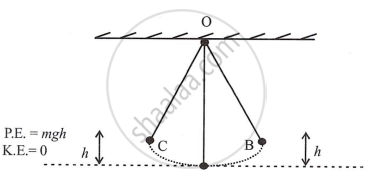Advertisements
Advertisements
प्रश्न
Name two examples in which the mechanical energy of a system remains constant.
उत्तर
(1) A body hurled vertically upward under gravity experiences a continuous increase in P.E. and a continuous decrease in KE. The sum of these two quantities at any one time stays constant.

(2) Because of the height h above ground and KE = 0, in the case of a simple pendulum at B, Bob just has P.E.
∴ Sum of P.E. + K.E. = mgh + 0 = mgh
At A the resting position h = 0 and P.E. = 0 but has maximum KE. (Since P.E. has been converted into KE.)
∴ Sum of P.E. and K.E. is same at A as at B.
Now again as bob rises above ground to position C, K.E., decreases to zero and P.E. = mgh
∴ Sum of P.E. and K.E. = mgh
We see that in all three places, P.E. + K.E., i.e., the mechanical energy of the system, remains constant.
APPEARS IN
संबंधित प्रश्न
State two advantages of geothermal energy.
State the changes in form of energy while producing hydro electricity.
A light mass and a heavy mass have equal momentum. Which will have more kinetic energy?
(Hint : Kinetic energy K = P2/2m where P is the momentum.)
Differentiate between the potential energy (U) and the kinetic energy (K).
How much electric power is generated in India using the wing energy?
Name a device in which solar energy is converted into electricity state its two uses.
State the energy changes which take place when:
A toy car spring is wound and car is made to run on level floor.
A body is thrown vertically upwards. Its velocity keeps on decreasing. What happens to its kinetic energy as its velocity becomes zero?
For the same kinetic energy of a body, what should be the change in its velocity if its mass is increased nine times?
A body of mass m is taken from a height h to 2h. What is the increase in its potential energy?
